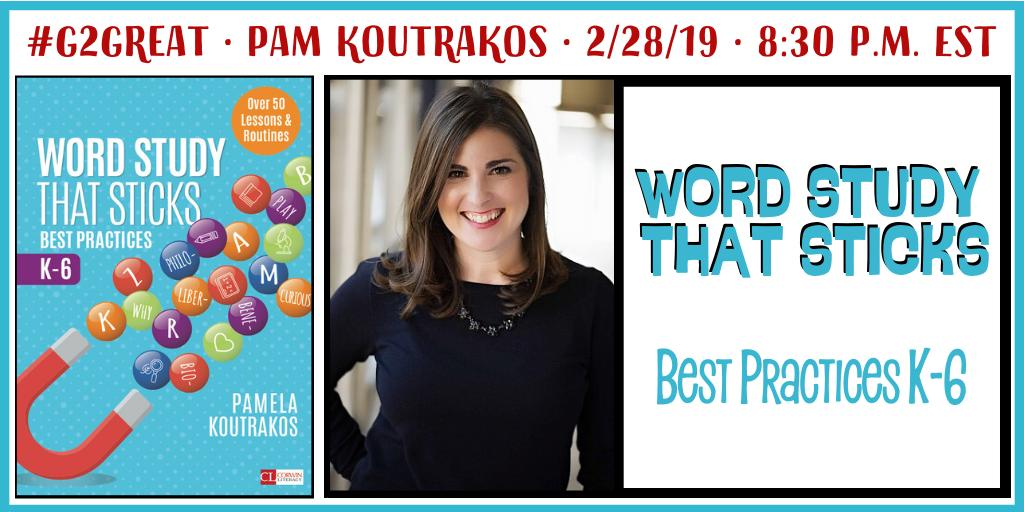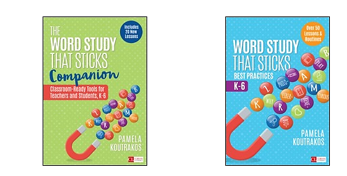By Valinda Kimmel

Pam Koutrakos, author of Word Study That Sticks: Best Practices in K-6 (Corwin, 2019), joined #g2great Thursday night, February 28, 2019 as our guest. For die hard logophiles like myself, it was a treat.
I’ve always had an affinity for word work in the classroom, but I know not all students (and teachers) share that love of words. Pam clearly and creatively shares with teachers numerous ways to make words come alive for kids through discussion, exploration and inquiry. Pam was kind enough to answer some questions about how the book found its way into teachers’ hands.
What motivated you to write this book? What impact did you hope that it would have in the professional world?
This book was spurred by a unique set of stars aligning:
Personally:
Growing up, I was an avid reader and writer. I loved learning and did well in school, but this “success” required great time and effort. I didn’t recognize that my process was so different from others because I somehow figured out my own set of strategies that compensated for letters that sometimes flipped, bounced, and reversed. It was only when I started working with students that I began to notice and understand my own hurdles-and feel quite impressed with how I managed to compensate all those years! This realization made me wonder how, even though I was surrounded by amazing, caring teachers, no one spotted this earlier. This led me to think more about what was valued- or even asked of me in school- and how little things had changed.
Socially:
I love reading about and hearing other perspectives, and also love engaging in conversation with people with whom I share passions and beliefs. Now more than ever, I think of words as a conduit for sharing who we are and what we believe. Words connect us with others and enable us to consider a multitude of perspectives. Words helps us feel seen, understood, and a part of a community. Words are also a catalyst for necessary change. The urgency to empower students with word competency is incredibly relevant and real.
Professionally:
As I made shifts in some of my own instructional practices (2 parts motivation and 1 part very informal action research), the positive outcomes were exhilarating. Reading, writing, and math transformed. I then looked at word study- and realized that I was using the same old practices. And these methods had the same old feeling- the same old outcomes- and were not cutting it. I knew change was needed, but didn’t know what else to try. So again… curiosity led me to research, tinker, and try. Later, as I traveled to schools and connected with educators, I discovered my experiences were far from unique. Teachers didn’t love what was in place and were concerned with lack of engagement, ownership, and transfer. Educators were craving structures that were more responsive to students and less one-size-fits-all. They sought practical and flexible ideas that could bring joy to word exploring and yield fruitful and lasting results.
This intersection of these personal, social, and professional reflections inspired me to share some of what I had tried in K-6 classrooms in a variety of communities.
I hope that this book makes sense to educators and the approach described seems inviting and possible. In my heart, this is a book by a teacher for teachers. I want readers to know that my own “figuring some of this out” journey has been filled with both frustrating and delightful twists and turns, and that I do not imagine anything I suggest will be carbon copied in classrooms. I hope this book gets teachers’ mind-wheels spinning, imagining how this kind of playful learning could look and feel in the settings they work in each day. End goal: colleagues near and far (we are all colleagues!) look to students, and respond with robust, jubilant instruction that matches the values, goals, and readiness of everyone in the learning community- teachers included!
What are your BIG takeaways from your book that you hope teachers will embrace in their teaching practices?
- Word study is not one thing: A developmentally appropriate, balanced approach to studying words includes phonemic awareness, phonics, spelling, meaning/vocabulary- and high frequency word work.
- Word study does not exist in isolation: So much can be done in even a few, consistent minutes spent exploring words. However, learning sticks when we make concerted efforts to integrate and embed word study throughout the day… just as consistently. Knowledge is a stepping stone- we also want students to understand the infinite whys, hows, whens they can apply and use word learning.
- A robust approach to word learning starts with the people in the room. As with all learning inside and outside of school, there’s not one right way. One exact, “every student, every time” scope and sequence (or set of methods) will not work for everyone. When we use what we know about students, get curious about finding out more, and actively invite and encourage learners of all ages to be active drivers of their own learning, we will find more success than we ever could have imagined.
- It is possible to integrate different styles learning— and methods of instruction— into a cohesive approach to word study. Inquiry and more direct instruction can co-exist. Collaborative discussion can be balanced with more introspective thinking time. Joy is at the heart of meaningful, authentic, research-based best practices.
What is a message from the heart you would like for every teacher to keep in mind?
Instead of focusing on the scary or challenging “what ifs” – begin to imagine the energizing and exciting possibilities “what ifs.” Small shifts yield powerful results. A few key reminders to keep in your mind and heart:
- Word study is worthy of our time and attention. It is not a dull, drab “extra thing” to put us over the edge. Word study is active and gratifying -and although so important, it radiates a lighthearted, ahhhh feeling.
- Trust in your students. Learners of all ages are incredibly capable and can do this.
- Trust in yourself. Set a small goal, commit to a shift- putting a realistic and feasible plan in place, and then get going! Monitor progress and celebrate all along the way. Share with others- and try your best to laugh and learn through the “dip” that often happens when we try something new or different.
MY FINAL THOUGHTS
If you have not yet read Word Study That Sticks, I hope you’ll buy it and put it at the top of your TBR (To Be Read) stack. Be looking for the Companion Guide from Corwin Press that is available June 2019.

Pam, thank you for sharing your book on word study with teachers. I hope all who read it will embrace the opportunity to move from a “have-to” instructional task to a “heart-felt” commitment that grows young readers and writers in their prowess as logophiles.
Word Study that Sticks Best Practices (Corwin, 2019) https://us.corwin.com/en-us/nam/word-study-that-sticks/book261198
Pam Koutrakos Blog post: How to Put Wind in the Sails of Students’ Curiosity about Language
Welcome! It’s official, Team Member Valinda KImmel. Your first post as a member of the #G2Great team. The first of many. Yay! Wahoo! 🙂
Interesting ideas here, especially that word work instruction has not changed, while reading, math, etc have changed. We still need guidance in research-based best practices for word work in the classroom.